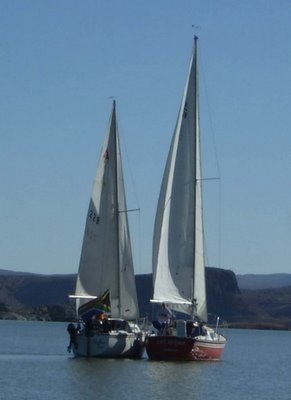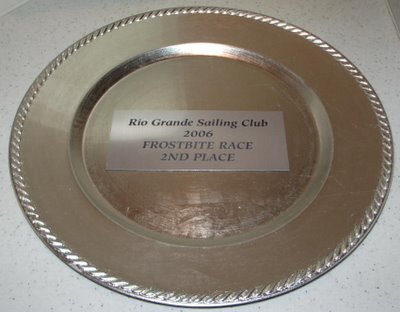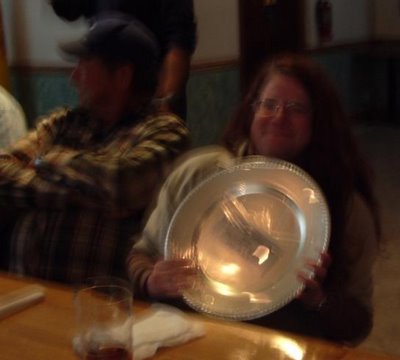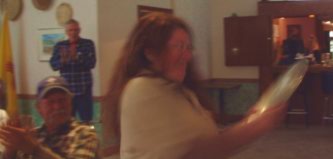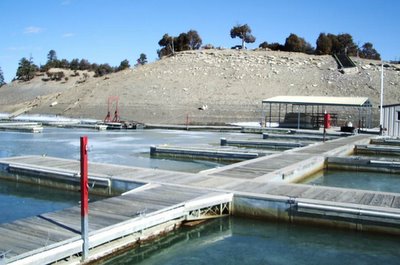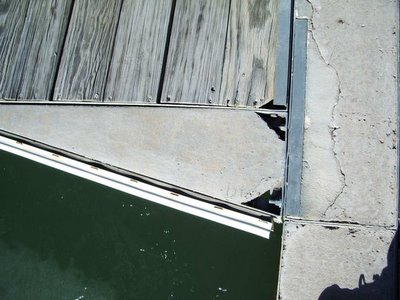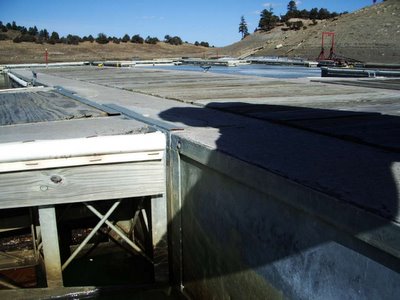Warning label: These are just my impressions and opinions and could be wrong. I'll be trying to correct any goofs, so this post may evolve and change.
This weekend's committee boat duty brought on a whole host of
"Oh no, not another learning experience!" happenings.
The skippers' meeting on Saturday morning had been well attended and convivial, but somewhat chaotic at times, and a couple of pieces of key information had probably not been announced or heard by everyone, as would be discovered later. Heading north from the Damsite Marina to do race committee boat duty on Saturday morning, I found that the southerly winds were already strong enough to let me run out the genoa to about 100% and motorsail much faster than under motor alone.
On Saturday, I had our boat out in plenty of time to drop the pin buoy and to anchor, thus establishing the starting line for the race. Originally, the plan had been for the big boats to do relatively short round-the-buoy races of a mile or two in length, while the rest of the fleet did a relatively long-distance race of five or six miles. Apparently, the plan had been changed at some point to have everyone do the distance race, which I found out only after I tried to fly signal flags for the big boats to do buoy races.
With winds forecast to be blustery in the 15 to 25 mph range, I had brought a "secret weapon" to keep our water-ballasted cabin sailboat on station come what may; a large anchor and heavy chain rode more suited to a 34-footer than our 25'10" water-ballasted lightweight MacGregor 26 (1994 swing centerboard classic). Out went the high-tensile-strength 22-pound Sentinel anchor, a significantly heavy boat length of 3/8" proof coil galvanized chain, and the bulk of 150 feet of 3/4-inch twisted-strand nylon line. Syzygy was in position to stay. (There used to be a center pin that the committee boat had tied to but that had deteriorated and drifted away, never replaced by the state park, so an adequate anchor was a must for any committee boat in windy weather.)
Unfortunately, the line wasn't square, leaving the committee boat end favored at the start by an angle of at least several degrees, and now that Syzygy was solidly anchored in place with me on the boat by myself, there wasn't time to try to weigh (raise) anchor and move the pin buoy at the other end of the line. I tried to call the other boats on channel 16, the hailing frequency on the VHF radio. I had told people I'd be monitoring channel 16 at the skippers' meeting previously, but no one had been paying much attention at the time and it turns out that 68 is the traditional channel for the committee. But, no one had mentioned that to me at the skipper's meeting and I didn't think to try that channel. So, I had a nice conversation with the friendly state parks folks but no word with our people. Also frustrating was that the race chairman passed by 50 or 100 yards away and tried shouting at me over the noise of the wind and waves. Even in calm conditions my hearing isn't at all perfect, so in this mess the distant shouts were pure gibberish. I could perhaps guess what he was shouting about, but couldn't make out the words or do a $^*&*^$%*! thing about it, especially as events later proved. So, I was frustrated and left on my own.
As the winds built, the light water-ballasted boat become rather a bucking bronco. But, at least it wasn't drifting anywhere, even if there was plenty of rockin' and rollin'. Hoisting flags, sounding horns, watching the clock, watching the starting line, and writing was too many handfuls of work for one person, but I got through it with only one horn signal sounded at the wrong moment. The fleet launched on their long-distance race and I finally got a chance to snap a picture as they headed off for the horizon. I had also flown the "Yankee" flag to require use of PFDs (life preservers) and anyone sensible would have had them on anyway.
The intervening time wasn't bad and the fleet leaders only took an hour and a half or so to finish; not bad at all. However, in the time that they'd been away from the committee boat and out of sight, there had been equipment failures and a crew overboard. Many of the race boats have no boarding (swim) ladders to help get someone out of the cold wintertime lake waters, and our small club didn't have a safety/rescue/crash boat to help someone in the cold water, so this was a very scary incident for the club.
Another boat had the boom come crashing down on Carol Anne's hat and head shortly after the boat left the marina and Carol Anne was standing in the companionway organizing her tactician's placard. The boom left a crease in her hat and a lump on her head as a souvenir when a new, high-tech high-dollar (but hard, small, and slick) halyard (rope that holds the big sail up) slipped out of a cleat that wouldn't hang on under any significant pressure. The cleat and new halyard were a marriage made in hell, with a potential for mayhem and carnage. (Actually, the owner notes that the cleats and halyards were new and that the boom never fell on Carol Anne, so I guess that lump and crease and falling boom were imaginary.) (The mainsail had also been raised with the outhaul not connected in spite of Carol Anne's warnings.)
The boat was a very good, fast boat, but it had not been campaigned but instead seems to have been sitting around in recent years and had issues with some equipment "not playing well together" in spite of a lot of new, high-tech running rigging, installed at quite some expense. [It was later found that a vendor had sent the owner the wrong kind of halyard line, with an easily compressed core that wouldn't stay put in the cleat.] The crew had to make do with jib alone, losing places to boats with mainsails or both sails, sailing on for pride and to complete the course but with hopes for victory crushed by those dratted little bitty pieces of untested hardware that had not worked together under breezy conditions.
Frightening also was the accident of
Cranky Wench, which had a crew member slide across the boat and into the water. After quite some time, perhaps 10 or 20 minutes or so, the crew was able to rescue her from the cold water after dumping sails and turning on the motor, trying some approaches, and getting a Lifesling rescue float out to the aquatic crew. Luckily,
Cranky Wench had just been given the Lifesling the day before! (Along with some brand-new jib cars (pulleys that go on a track) from a coach.) Not so good was that the overboard crew member didn't really know how to use the Lifesling, was showing signs of hypothermia, and the boat, like others of its type, had no boarding ladder, and did not have lower lifelines installed. (It's somewhat fashionable for some J's to come without lower lifelines but might cause rules problems when the crew hikes.) If Rich Strasia hadn't had the strength to haul the person overboard out of the water, this accident could have ended in tragedy. The crew got her into dry clothes but their decision to continue racing might have turned out to be a terrible one if the hypothermia had progressed to serious stages before the crew decided to quit racing, were able to get to shore, and seek medical care with the small local hospital about 8 miles distant.
Another boat,
Cultural Infidel, was dueling the C&C 30
Luna C for first-to-finish.
Luna C had a better angle to the finish and crossed the line, but after sounding a horn and writing down the time I looked up to see
Cultural Infidel peeling off just 50 yards short of the line and heading away from the line toward the Rock Canyon marina. Later I learned that a steering fitting had failed, leaving the boat with poor, mushy steering; and at first Russ and crew were not sure that they had much steering at all and had put the boat under motor power and out of the race.
The J-22
Scirocco's Song, and the J-24s
Coyote,
Cranky Wench, Goat Rodeo, and eventually the last finisher, the Hunter 34
Windependent, crossed the line and I could organize and pack gear and get ready to head for port behind the fleet.
Then came the fun part: That big heavy anchor on a small, bucking boat with no roller or windlass, was a bear and a half to hoist. I was nervous spending so much time on the bow among the spray, splash, and breaking whitecaps. Soon I was exhausted after hoisting a bit of rode with each downward movement of the bow that made hoisting possible. Eventually I put the rode around a winch, but cranking was slow and hard for various reasons: the rode was too large for our tiny winches, so I could only get two wraps and very little friction on the rode, requiring that I put a huge effort with one arm to tail (pull) while the other arm cranked the winch handle. Also, with no bow roller, the rode came up over the rubrail and then past a stanchion base, adding a load of friction to the effort of lifting the already heavy stuff. Because I was alone in heavy winds, motoring up to the anchor did no good - - our boat is hard to keep head-to-wind and the boat would drift back before I could go forward to take in more anchor. So, it took me 40 minutes to hoist anchor. Ironically, someone on shore made a joke that evening that I was probably not there because I was trying to hoist the super anchor. At least the state parks rescue boat was keeping an eye on me and came over to visit and chat while I tried to catch my breath and massage cramping muscles.
Then came yet another challenge: Once the anchor had been partially broken free, our boat had started drifting, drifting a third or half mile downwind of the pin, which I now needed to retrieve. But, before I could retrieve it, I had to find it in the driving spray and crashing waves. Worse, the conditions wouldn't let me motor directly upwind or on certain other headings; if I tried to go straight up the offset-to-port-mounted outboard motor's lower unit would pop out of the water, causing the motor to race and losing propulsion. So, even though I was under motor, I had to tack upwind! Eventually the parks guy, after first suggesting that I leave the pin overnight (the state parks folks were the ones who had required us to remove our former Olympic Circle buoys a year or two back!), helped point me toward the pin. After several passes, I was able to retrieve it. By then, all the other boats were long since home in their marinas or driveways and people had long since started celebrating the end of the day, far from the cares of the bedraggled race committee of one lonely, wet, soaked, sailor.
Then, I got to enjoy a wet, splashy motor back to the DamSite Marina at the end of the lake and drag my battered beaten carcass up and down the hill to the truck and slowly drive to the restaurant where the club would meet - - after having to stop partway for a bad attack of muscle cramps in my side; previously motoring in I had experienced a strange thumb cramp that left me unable to grasp items with my right hand for a while and aches and cramps in assorted other places.
During the night's dinner, the race chair decided that if conditions for Sunday looked anywhere near as bad as Saturday's that the race would be cancelled. With no rescue boat and the day's frightening crew-overboard and falling boom accidents and gear failures, that was a wise decision. One thought was that the winds would perhaps hold off enough in the morning to allow for racing to be completed Sunday morning before things got too hairy. That night, internet weather services predicted sustained winds of 15 to 19 mph for Sunday afternoon but lighter winds of 5 to 13 mph for the morning; the Weather Channel predicted winds of 15 to 25 mph, the same as for Saturday.
Sunday, February 19: Mo' Troubles
Sunday morning dawned with us up early and the Weather Channel predicting winds of 15 to 25 mph, as before. We were quite sure that there would be no race under those conditions, but I was duty bound to get the committee boat out, especially if there would be an attempt to perhaps have some short buoy races instead of the distance race that had been planned originally. I put a couple of gallons of gas with some 50:1 oil into the tank and motored out toward the race course. Then, the engine sputtered out. Attempts to restart it were futile. I checked the cut-off switch to make sure it hadn't cut off and experimented with the choke and throttle; no good. The starter was willing, but cranking didn't accomplish anything.
Then I saw that the fuel line was completely cut off. No gas, no go. The fuel line on Syzygy had probably become brittle from ultraviolet (UV) sun and exposure and weathering and simply broken off neatly at a point just an inch outside where the line exits the lazerette (storage locker) and enters the motor well. I unrolled the jib and tried to sail back to the marina in 15 - 18 mph winds but the swing centerboard had jammed in the up position and refused to come down. It may have gotten stuck the day before when I was having trouble with it catching on part of the marina or something under the slip. With no centerboard, the boat could not claw off the threatening rocks waiting for me on the lee shore. Plus, by myself, I found tacking difficult; I couldn't leave the tiller for long to try to sheet the jib. Realizing that I would soon be on a rocky shore, I picked out a relatively benign spot of shore to beach Syzygy, tie up, and await rescue which fortunately wasn't too long in coming. I heard myself discussed on the radio, joined the conversation, and prepared to be rescued. Unfortunately, there wasn't a kettle or tea on board, so I didn't have a chance to brew up a warm beverage.
Windpendent came by first, but was in danger of being blown onto the lee shore, and Mark Paz in a DamSite power boat was in sight and on his way, so I waved Marty and
Windependent off before he and his crew risked getting their big, less maneuverable boat into big trouble on sharp rocks. Even though Marty said he was still in fourteen feet, he was still out of range for me to throw my tow rope upwind. I by then prepared the storm anchor rode as a sturdy tow rope, and was easily able to pass it to the power boat, which took up slack, gave me a moment to untie my bow line from a rock on shore and shove
Syzygy off the cobbles carefully and board. After getting far enough from shore, we transferred from the aft-cleated tow rope to the bow line and I worked the rudder to help maneuver
Syzygy to the marina, where the power boat let me loose while I had just enough steerage to coast into a vacant outer slip.
Then I and
Windpendent's crew had to transfer gear to the alternate committee boat. This took some time; my gear took up room and the race committee's big box of gear, flags, buoys, anchors, etc., took a while to load into dock carts and move to
Windependent, which was halfway across the marina at the fuel dock. So, all in all, we did quite well to have Sunday's start at 10:52 AM, delayed less than an hour from plan and well before Saturday's windy 1:01 PM start. We had scrambled to have the start as fast as possible at the race chair's urging. By then, we had picked up an additional crew member who had boarded from Russ and Maria's
Cultural Infidel; the Infidels had decided not to race on Sunday and Buzz Biernacki left them and came aboard the committee boat to watch some of the action.
Of course, the fact that we were having a start at all was a bit of a surprise, because the winds were already rather powerful and expected to build. Also, it was surprising to me that the race chair stuck with the planned distance (about five or six mile) race instead of opting for a shortened course or buoy races with boats and crews within sight of the committee boat and each other. This would have had some advantages in keeping boats in sight of the race committee, making it easier to see if a boat and crew got into trouble, having boats closer in case rescue was called for, and in having shorter races so that racing could be ended easily after any races if conditions became hairy.
This day was also different in that at least there was a big, stable committee boat. Unfortunately, although it had a just-dandy bow roller and anchor locker, the moderate-sized anchor and the short rode (less than two-to-one scope and less anchor and chain weight than I'd used on my much smaller boat on Saturday) were inadequate for the big, unwieldy boat; it dragged anchor after the start, covering 300 or 400 yards in an hour.
Before boats started finishing, we had to raise the anchor, which was difficult because
Windependent didn't want to head into the wind or toward the anchor, making a strenuous job for me and Buzz Biernacki to weigh anchor against the pull of the several-ton boat. Unfortunately, although we got the anchor up and got back to the line, the boat wound up stopping and dropping anchor very close to the pin buoy marking the other end of the line. This made for a tiny, eccentric, short, oddly-angled finish line that was difficult for boats to cross properly. It also led the skipper to worry about the possibility of
Windependent's stern weathercocking and swinging toward the line as a racing boat tried to finish. However, and also unfortunately, there wound up not being so many boats to cross that line as the day before.
I guess folks hadn't learned enough from the day before, except for the boats and crew members who didn't show up on Sunday. Conditions were starting off heavier earlier and we still didn't have a rescue boat on hand. Some of the racing boats still didn't have boarding ladders or retrieval equipment. Some of the boats were still undercrewed, with some having started out shorthanded and others losing crew after Saturday's racing, leaving the remaining crews stretched dangerously thin for the heavy conditions. Also, perhaps the race chair really wanted to demonstrate how dangerous and unpredictable distance races could be. Unfortunately, this demonstration was to have its price, though fortunately not a fatal one.
Seven of eight boats finished on Saturday. A ninth had registered but not started.
Only four were finish on Sunday. Two of the big boats didn't start, but the crew of the C&C 30
Luna C were first to finish, as they had been on Saturday. The J-24
Coyote didn't finish but instead headed for the Damsite, but the other J-boats were still in the chase.
Equipment and safety continued to be an issue, with the same crew who had gone swimming the day before almost taking another Esther Williams aquatic escape off of
Cranky Wench and other boats retiring from the regatta. Those lower lifelines will likely be installed very soon!
Carol Anne, helming a boat with only one coach and one other crew member was short-handed but Ken had improvised a way to get the main halyard secured to keep the mainsail up (after the halyard and its cleat had failed to play together on Saturday and the starboard jib car had wandered up and down a bent jib track on Saturday but behaved better on Sunday after Ken the coaches had a go at it). The crew passed some of the other boats and given the them a taste of bad air in their wake.
They had worked their way up the fleet and were closing in on the lead J-boat,
Kachina with Sue Strasia at the helm, when high sprits took a sudden beating. A sudden wind started to push the boat into a an uncontrolled tack and knockdown. Carol Anne had been holding the mainsheet at the time and tried to let off the mainsheet (the rope that holds the boom and mainsail close or far from the boat; loosening it enough will take power out of the sail when the boat is headed upwind). First Carol Anne tried yanking with one hand (the other hand had to grip the tiller) to pull the sheet out of the cam cleat but that didn't work. Carol Anne remembered what she had been told about kicking the sheet up out of the camcleat (though that action can have some negative side effects) and kicked and kicked at it without success. Soon her crew was screaming at Carol Anne to blow the main; Carol Anne was yelling back that she was trying. The boat kept going over. The cam cleat was jammed and not working properly; the left cam was not moving but stayed frozen stuck. Finally, a kick booted the sheet out of the cam. The sheet ran out for a few feet, freeing the main slightly, but then caught again in the cantankerous cam. So, Carol Anne had to kick it hard a couple more times to get it to finally loosen the sheet for good and relieve pressure on the sail. (The owner however, although not present on Sunday, believes that Carol Anne simply didn't think to dump the main and had to be reminded by the crew; she says that there were no equipment problems and that the knockdown was all Carol Anne's fault.)
By the time the sail had been released, the side of the boat had been driven deep into the water leaving the crew exhausted and gasping and definitely out of sorts - - the other crew member had barely hung on and had had water almost up to her chin.
Their coach proposed a rest to sort things out and get the boat back into shape; he moved to the helm position and tried to put the boat in "neutral". But, this too proved to be inopportune when a powerful, unannounced, 180-degree wind shift - - some people said it was more like a vortex or cyclone of swirling winds - - shot the unsheeted boom across the boat. Carol Anne felt a sudden terrible pain and then found herself on the floor of the cockpit with her glasses and her special lucky Aussie hat gone and the other crew standing over her saying, "Get up, Carol Anne, get up!"
Upon doing so, she found the boat in a mess with their coach bleeding profusely from a gash in his forehead. The coach turned on the motor after getting the latch to work to lower it into the water and Carol Anne took over the helm, turning back toward the committee boat and marina. The coach and the other crew alternated between using pads from the first aid kit to staunch the blood pouring from the coach's forehead and trying to get the mainsail down by dumping the main halyard (the rope that holds the mainsail up), but the slip knot that was holding it in place of the failed cleat now proved to be a terrible enemy; the knot had hardened, leaving the halyard welded in place. Shortly thereafter though some good news came as Carol Anne's glasses appeared. The coach's glasses had been hanging around his neck but weren't so fortunate; the boom had clobbered one of the lenses and the other was covered in bloom. Later, Carol Anne got the boat into a wider part of the lake and head to wind to take pressure off the sail so that the rest of the crew could undo the knot and get the sail down.
After arriving at the marina, Carol Anne told the rest of the crew that she had also been hit by the boom and had been bleeding; her red hair had made her bleeding less obvious and she had turned the injured side of her head from the rest of the crew so they wouldn't be any more upset or alarmed then they were already. That, plus the stress of the accident, had kept them from noticing Carol Anne's wound and adrenaline had kept Carol Anne going. Larry and a bystander (Kenny?) and a paramedic helped them at the marina after commenting upon the apparent battle royal and bloody scene, and the bystander led the way the the nearest hospital - - Carol Anne's crew had to drive Ken's manual-shift diesel truck, not necessarily an easy task, to the Sierra County medical center.
There, one nurse took Carol Anne into a room and another took the coach into another room. Vital signs were recorded and the wounds were cleaned and then examined by a physician. A waterproof cape or curtain had been put around each patient while the wounds were being cleaned and prepped, and then Carol Anne got four staples applied the coach a whole big bunch of stiches. The coach's wound was worse and so he also got to stick around for a CAT scan to make sure things weren't scrambled. Carol Anne was discharged with a list of instructions, which included someone checking on her every hour to make sure she didn't go unconscious. Also, the medical staff had given her a tetanus shot as a precaution. Before giving her the shot, they had asked her which arm she'd prefer to have sore for several days. With her left arm already sore from "tiller elbow" from the previous weekends that was the one she picked.
The committee boat had meantime got into port, and while I was loading committee and personal gear onto a dock cart we noticed someone waving from the restaurant area up the hill above the marina. It turned out to be RGSC commodore Richard Dittmar. I told the rest of the crew that I'd only be gone for a few minutes and went up with a few things, leaving the rest piled in and on top of a dock cart.
I climbed the hill only to be stunned as I approached and Richard told me that Carol Anne and the coach had been taken to the hospital. S*! I said in shock. Richard reassured me that things didn't seem too bad, but I was still upset all over and not at all happy that the distance race had been held in these conditions. Fortunately, when we got to the hospital and Richard let me out of the truck, I was hugely relieved to see Carol Anne walking out of the hospital's back door / emergency area with her other crew member - - Carol Anne looked and spoke with more composure and was incredibly upbeat and courageous about the whole misadventure. I was in awe, though still also in turmoil mixed with relief and thankfulness that things hadn't been worse.
Then I got my turn a driving a manual transmission for the first time in quite a while; our task was to take the coach's truck to the Strasia compound while Richard and the other crew member waited for the coach to be discharged. My instructions were to check on Carol Anne every hour and wake her if necessary to make sure she didn't leave consciousness. We were glad to get to the Strasia's compound and reassure people that things were not as bad as they could have been. Gerald had tried to call me on the cell phone earlier, as Richard and I had left the Damsite, but reception was poor and the call had been cut off. There was more celebration when Richard returned about 40 minutes later with Lisa and "Bloody Coach", his pants still splattered with blood, a small amount of which was licked off by the resident canines, Lucita and Dodie Coyote.
We also received a suggestion from the old days of fighting sail and Nelson's Navy, when before battle the crews of wooden line-of-battle ships would sprinkle the decks with sawdust to soak up the bloody of the ensuing battle so that men wouldn't lose their footing. However, the last time the gals checked, we didn't have any buckets of sawdust aboard any of our race boats. That will be changed soon. If any challenger crews show up for the Adams Cup, the local women will hoist the bloody flag and neither expect nor give any quarter. Now that she's been properly blooded, Carol Anne and the rest of the gals are ready to inflict maximum carnage on any opponents foolish enough to challenge them. Aaarrgh, mateys!
Also, previously at the hospital Carol Anne's crew had worried about whether anyone would clean up the boat they'd crewed upon; Carol Anne said that it looked like a cheesy slasher horror movie had been shot on board, with blood all over the cockpit. Fortunately, Rich Strasia reassured the group that the boat had been cleaned to something like its pre-accident state. Also, Buzz Biernacki appeared at the compound with our personal stuff and the race committee equipment, so everything was where it belonged except for Carol Anne's sailing gloves. The gloves, and her crew's morale, were what concerned Carol Anne, rather than the wound.
Rich also took notice of the additional boat fixes that had been discovered on Sunday and added them to his to-do list (jib track and cars, cleats for the traveller and sheets), along with things like installing the missing topping lift (it may not have needed a topping lift in San Francisco Bay's heavy airs when sailing for a previous owner) that the owner had planned to order.
The crew and coach had been exhilarated earlier when they had passed other boats and threatened the club's sailboat-racing queen, Sue. Carol Anne had the leaders in her sights but a unlucky wind and equipment problems left her and her crew feeling cheated and licking their wounds. She doesn't want to be frustrated again. It would probably be a very bad idea since she's capable of applying a great deal of power against any obstacles that have the temerity to interpose themselves in her path.




